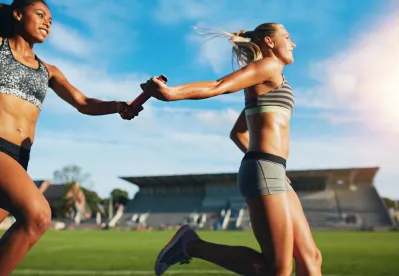Our dedicated Women’s Sport Group hosted its inaugural Women’s Sport Symposium on 29 February 2024 to discuss key issues across the women’s sporting landscape. Amongst other topics, a panel of key figures and experts, which was chaired by Sarah Butler (Founder of Sports Business Connected), discussed the pertinent issue of the commercialisation of women’s sports rights.
Key Opportunities and Challenges
Women’s sport, and the commercialisation of its rights, is at a crucial crossroads in its development. The exponential growth in the viewership and visibility of women’s sport in recent years has been widely reported and rightly celebrated. As covered in a previous Sports Shorts blog post, 2023 was another record-breaking year with 46.7m people tuning in to watch women’s sport on linear TV, surpassing the previous record set in 2019 by nearly a million.[1] Women’s elite sport is also predicted to break through the billion-dollar barrier and generate global revenues in excess of $1bn for the first time in 2024.[2] Whilst the numbers make for great reading and present numerous opportunities, they also bring with them certain challenges.
Free-to-air vs. Paywall
In terms of broadcast rights, the increased visibility of women’s sport has predominately been driven by free-to-air channels. Whilst the BBC and ITV only accounted for 11% of the total coverage hours of women’s sport in 2023, they accounted for 77% of total viewing hours.[3]
Hannah Brown (Co-CEO of Women’s Football at DAZN) commented at our Women’s Sport Symposium that DAZN’s strategy is to make women’s football “free to watch” at this stage of its development. In January this year, DAZN removed the paywall from all live women’s football matches on its platform, thus removing that initial barrier to entry in order to continue to scale and engage a global audience. The dilemma of how best to monetise women’s sport is at the forefront of the mind of rightsowners’ too. Whilst free-to-air coverage has been critical in driving the growth in viewership of women’s sport, determining to what extent and at what point it is appropriate to pivot or transition to paid-offerings, will be significant.
In order to maximise the audience for a number of women’s sports properties, both rightsowners and broadcasters have relied on YouTube’s ready-made global reach and its comprehensive datasets. There is of course a trade-off between such benefits and the facility of establishing a direct relationship with fans via the rightsowner’s or broadcaster’s own platform and the greater direct commercial opportunities that such a first-hand relationship presents.
Pinnacle vs. Pyramid
As may be expected, the record viewership figures in women’s sports have been driven by international sporting events that take place every few years. Last year saw the coincidence of several pinnacle properties, including the FIFA Women’s World Cup, the Women’s Ashes Series, the Netball World Cup and the Solheim Cup, which were each further boosted by England (or Europe) reaching the respective tournament finals or competing in nail-bitingly close competitions. Football, in particular, remains the pinnacle sport, constituting 74% of total viewing hours for women’s sport, with the FIFA Women’s World Cup accounting for 70% of those football viewing hours.[4]
There is a great opportunity to capitalise on these record numbers off the back of these pinnacle properties. As these events only take place every few years, the current challenge is how best to convert these eyeballs into consistent consumers of women’s sport. A key challenge for the rightsowners in this growth phase for women’s sport will be for each of them to learn more about their individual audiences, what their preferences are, and how best these can be served.
Julia Wall-Clarke (Head of Communications at Hexagon Cup) outlined this exciting opportunity for women’s sport to empower itself to adopt a start-up mentality and rip up the rule book and work on new, innovative formats and ways of thinking. Even with leading women’s football properties, which are some of the more dominant and established in the sector, they should not be immune to change.
“With women’s football, it feels like a 100-year-old start-up; it’s an established sport, but the women’s game is still comparatively new and has the opportunity to do things differently.”
Julia Wall-Clarke, Head of Communications – Hexagon Cup
Bundled vs. Unbundled
As women’s sports properties continue to grow in prominence, so there are greater calls for these properties to be “unbundled” from their related men’s properties – i.e. to allow women’s sports properties to create partnerships that align with values that are unique to those properties and their audiences.
There have been challenges for women’s sports properties that have been unbundled for the first time, particularly from a broadcast perspective. However, once that bold move has been taken and a specific value has been ascribed to those properties, then their commercial value can be more accurately determined and grow for future rights cycles. For example, last year it was well-publicised that FIFA initially struggled to reach agreements with broadcasters in key markets for the FIFA Women’s World Cup which met their target valuations. However, given the success of the tournament and TV audiences achieved, it is difficult not to foresee that rights values will increase materially for the tournament’s next edition.
The unbundling of sponsorship rights is also predicted to gather pace.[5] In recent years, this has led to ground-breaking, women’s only partnerships, including those between Charlotte Tilbury and F1 Academy (the beauty brand’s first ever global sports sponsorship), as well as Stella McCartney and Arsenal Women (creating a bespoke limited-edition kit and clothing range for the women’s team). Whilst these women’s only deals present unique opportunities for brands to enter into the sports sponsorship market, the challenge is to ensure that these deals supplement, rather than replace, other core commercial partnerships.
“There can be a conflict between commercial partnerships for the men’s and women’s teams as clubs may seek to prioritise core sector partnerships (e.g. in the financial services or insurance sectors) with the men’s team as these are more lucrative. Partnerships between the likes of Charlotte Tilbury and F1 Academy are very interesting and great for promoting women’s sport, but of course we don’t want to limit partnerships to sectors such as beauty brands at the expense of core sector deals.”
Rachel Knight, Managing Director – Women’s Sport Group
Scheduling
With an increasingly congested sporting calendar, it is crucial that women’s sports properties are scheduled appropriately in order to maximise their exposure to both their current fanbase but also the opportunity to access new audiences. As we have discussed in a previous Sports Shorts blog post, there continues to be much discussion around whether the current protected period on a Saturday afternoon could provide a dedicated broadcast slot for women’s football.
Not only does scheduling play a crucial role in enhancing the visibility of women’s sport on TV, and in turn driving the value of broadcast rights and sponsorship deals, but it is also pivotal in encouraging matchday attendance. Whilst matchday may not necessarily itself be the biggest standalone revenue generator for women’s sport, it plays a vital role in generating an atmosphere, enhancing the product and also advancing these other revenue streams. As Hannah Brown (Co-CEO of Women’s Football at DAZN) noted at our Women’s Sport Symposium – from a broadcaster’s perspective, “Matchday is key. If we don’t get matchday right, we don’t win“. Investing in creating a compelling matchday product, which can be aided by favourable scheduling to promote bigger matchday crowds and greater in-stadium buzz, in turn drives broadcasting and sponsorship value.
“Matchday is key. If we don’t get matchday right, we don’t win”
Hannah Brown, Co-CEO of Women’s Football – DAZN
Exploiting the opportunity
Women’s sport is at an exciting and important juncture in its development, with great capacity for further growth. In order to maximise its growth opportunities, it seems that a fundamental priority is for its various rightsowners and stakeholders to gain a greater understanding of their current fanbase and the opportunities for this to grow. It is only through gaining this greater insight into its fans (and their interests and characteristics) that rightsowners give themselves the greatest opportunities to maximise the breadth and depth of the commercialisation of their properties. Whilst women’s sports rightsowners can always look to more traditional and established men’s properties, it is important that they do not feel wedded to blindly follow their status quo and are empowered to cater to their unique audiences and reach new ones. As outlined above, there are numerous important decisions to be made, and the optimal solution (informed by data) will require a joined-up approach across stakeholders, including clubs, leagues, media, sponsors and broadcasters – as well, of course, as further investment.
[1] Visibility Uncovered, 2023 – The Year in Review: A Women’s Sport Trust Report into Visibility, Women’s Sport Trust (February 2024), p 7.
[2] Deloitte, “Breaking the billion-dollar barrier: Women’s elite sports to generate more than $1 billion in revenue in 2024” (29 November 2023) [accessed online here].
[3] Visibility Uncovered, 2023 – The Year in Review: A Women’s Sport Trust Report into Visibility, Women’s Sport Trust (February 2024), p 11.
[4] Visibility Uncovered, 2023 – The Year in Review: A Women’s Sport Trust Report into Visibility, Women’s Sport Trust (February 2024), p 56.
[5] Deloitte, “Women’s elite sports: Breaking the billion-dollar barrier” [accessed online here].
Jack Wood also contributed to this article.




 />i
/>i

